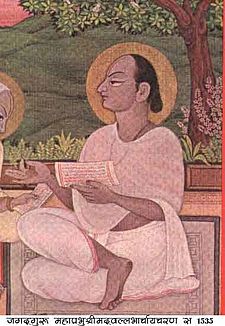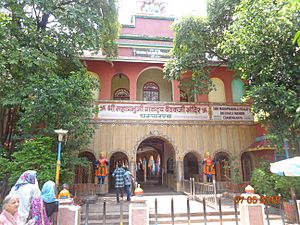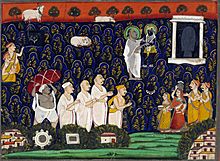Vallabha facts for kids
Quick facts for kids Jagadguru Aacharya Shree Vallabhacharya ji Mahaprabhu |
|
|---|---|
 |
|
| Birth Date | 27 April 1479 Champaran (now in Gariaband district, Chhattisgarh, India) |
| Died on | 26 June 1531 (aged 52) Banaras (now in Uttar Pradesh, India) |
| Philosophy | Shuddhadvaita, Pushtimarg |
Vallabhacharya (1479–1531 CE), also known as Vallabha, was an Indian philosopher who founded the Krishna-centered Pushti sect of Vaishnavism in the Braj region of India, and the philosophy of Shuddha advaita (Pure Nondualism).
Vallabha was born in a Telugu family that had been living in Varanasi, who escaped to Champaran of Chhattisgarh state while expecting Vallabha, expecting a Muslim invasion, which ultimately didn't happen, during the late 15th century. Vallabha studied the Vedas and the Upanishads as a child, then travelled throughout the Indian subcontinent over 20 years. He became one of the important leaders of the devotional Bhakti movement. Vallabhacharya's mother was Illamma who was the daughter of a family priest serving the rulers of the empire of Vijayanagara. The hagiographies written by his followers, just like those for other Bhakti leaders, claim that he won many philosophical debates against the followers of Ramanuja, Madhvacharya and others, had visions and miracles.
He is the Acharya and Guru of the Pushti sub-tradition, which he founded after his own interpretation of the Vedanta philosophy. Vallabha rejected asceticism and monastic life, suggested that through loving devotion to God Krishna, any householder could achieve salvation – an idea that became influential all over India, proven by his 84 Baithakjis (Places of worship) in Uttar Pradesh, Rajasthan, Gujarat, Maharashtra, Tamil Nadu, Andhra Pradesh, Karnataka, Keral, Uttaranchal, Madhya Pradesh, Orissa, Goa and various other parts of India.
He is associated with Vishnuswami, and is the prominent Acharya of Rudra Sampradaya out of the four traditional Vaishnava Sampradayas.
He authored many texts including the Anubhashya (a commentary on Brahm Sutra), Shodash Granth or sixteen 'stotras' (tracts) and several commentaries on the Bhagavata Purana. Vallabha's writings and kirtan compositions focus on baby Krishna and his childhood pranks with Yashoda (unconditional motherly love), as well as a youthful Krishna's protection of the good (divine grace) and his victory over demons and evils, all with allegory and symbolism. His legacy is best preserved in the Braj region, and particularly at Nathdwara in Mewar region of India – an important Krishna pilgrimage center. He called himself an incarnation of Agni.
Contents
Life
Childhood
The ancestors of Vallabhacharya hailed from the Andhra region and belonged to a long line of Telugu Vaidiki Brahmins known as Velanadu or Vellanatiya following the Vishnu Swami school of thought. According to devotional accounts, Krishna commanded his ancestor Yagnanarayana Bhatta that he would take birth in their family after completion of 100 Somayagnas (fire sacrifices). By the time of Yagnanarayana's descendant Lakshmana Bhatta who migrated to the holy town of Varanasi, the family had completed 100 Somayagnas. Vallabhacharya was born to Shri Lakshmana Bhatta in 1479 CE (V.S. 1535) on the 11th day of the dark half of lunar month of chaitra at Champaranya, now in Chhattisgarh. The name of his mother was Yellamma.
The period surrounding Vallabhacharya's birth was a tumultuous one and most of northern and central India was being influenced by Muslim invaders. It was common for populations to migrate in order to flee from religious persecution and conversion. On one such occasion, Shri Lakshmana Bhatta had to urgently move out of Varanasi with his pregnant wife. Due to terror and physical strain of the flight suffered by the mother, there was a premature birth of the child, two months in advance. As the child did not show signs of life, the parents placed it under a tree wrapped in a piece of cloth. It is believed that Krishna appeared in a dream before the parents of Vallabhacharya and signified that He Himself had taken birth as the child. According to popular accounts, the parents rushed to the spot and were amazed to find their baby alive and protected by a circle of divine fire. The blessed mother extended her arms into the fire unscathed; she received from the fire the divine baby, gleefully to her bosom. The child was named Vallabha (meaning "dear one" in Sanskrit).
Education
His education commenced at the age of seven with the study of four Vedas. He acquired mastery over the books expounding the six systems of Indian philosophy. He also learnt and studied philosophical systems of Adi Sankara, Ramanuja, Madhva, Nimbarka along with the Buddhist and Jain schools. He was able to recite a hundred mantras, not only from beginning to end but also in reverse order. At Vyankateshwar and Lakshmana Balaji, he made a strong impression on the public as an embodiment of knowledge. He was now applauded as Bala Saraswati.
After studying till age of 11, he went to Vrindavan.
Victory at Vijayanagara
In the court of king Krishnadevaraya, a debate was conducted at Vijayanagara between the Vaishnavaites of Madhva and Shankars over the philosophical question whether God is Dualistic or non-dualistic. Vallabhacharya participated in the discussion.
At the age of 11, Vallabhacharya, who had earned an epithet of Bala Saraswati was given the opportunity to discuss the question. The discussion continued for 27 days in the conference hall. He was honoured with the kanakabhishekam ceremony by the emperor Krishnadevaraya on victory. The titles of ‘Acharya’ and 'Jagadguru' (world preceptor) were conferred on him. He was offered vessels of gold weighing a hundred maunds. Vallabhacharya politely declined to accept them and distributed them among the poor learned brahmins and kept only seven gold mohurs. They were used for preparing the ornaments of Vithoba (Vitthalanatha) in Pandharpur.
Pilgrimage of India (prithvi parikrama)
Vallabhacharya performed three pilgrimages of India, barefoot.
He wore a simple white dhoti and a Upparna a white uper garment cloth (known as ‘Upavarna’, literally "upper cloth" in Sanskrit) and make no use of his khadau (footwear) . He gave discourses on Bhagavata at 84 places and explained the meanings of the Puranic text. This 84 places are known as Chaurāsi Baithak (चौरासी बैठक) and now they are places of pilgrimage. He stayed in Vraja for four months in each year.
Establishment of Pushtimarg Vallabh Sampraday
It is believed that when Vallabhacharya entered shri Gokul, he thought about the important question of restoring people to the right path of devotion. He meditated on Krishna who appeared to him in a vision in the form of Shrinathji, a deity discovered by Madhavendra Puri and disclosed the 'Brahma Sambandha' (Sanskrit for "relation with Brahman, the supreme Godhead"), a mantra of self dedication or consecration of self to Krishna. During that time Damodardasa, his disciple, was sleeping next to him. In the early morning, Vallabhacharya related this experience to Damodardasa and asked him — “Damala, did you hear any voice last night”? Damodaradasa replied that "I heard something but was not able to understand the meaning of it." Vallabhacharya then explained the meaning of the mantra and at that time he became the first Vaishnava initiated by Vallabhacharya.
Vallabhacharya wanted to preach his message of devotion to God and God’s grace called Pushtimarg (path of grace). He undertook three pilgrimages of India. He performed the initiation ceremony of religious rite by conferring on them the ‘Nama Nivedana’ mantra or the ‘Brahma Sambandha’ mantra. Thousands became his disciples, but 84 devoted servants are most famous and their life has been documented in Pushtimarg literature as the ‘Story of 84 Vaishnavas’. He also met Vyas in his Himalayan cave and discussed Krishna and his flute.
Personal life
He intended to remain a lifelong celibate but the deity-guru Vithoba of Pandharpur commanded him to marry and live the life of a householder, and Shrinathji himself said that He would be born as the second child of Vallabha, Gusaiji (as Vallabha's first child Gopinathji is the form of Balram). Obeying his guru, he married Mahalaxmi and had two sons, Gopinathji and Vitthalnathji (also known as Gusainji).
Death
At the age of 52, he took samadhi in the Ganga river in Hanuman Ghat of Kasi.
Based on Pushti Marg literature, in about 1530 A.D., Shrinathji commanded Vallabhacharya to leave the worldly life and to come near Him. It is said that Shrinathji had previously expressed His wish on two different occasions. The third command was accepted by Vallabhacharya as the last verdict. He reached Kasi and according to Vedic traditions, formally renounced the world by taking Sanyasa and a vow of silence. He lived in a hut made of leaves on the Hanuman ghat for about a week. He spent his last days in contemplation of Krishna and suffered agonies of separation from Him. The members of his family assembled near him for his last darshan. When asked about his advice, Vallabhacharya scribbled three and a half Sanskrit verses in the sand by way of counsel. To complete this message, it is believed that Krishna Himself manifested visually on the spot and wrote in the form of a verse and a half. This collection of verses is known as ‘ShikshaSloki’ in Pushti Marg literature. He entered into the waters of the Ganges on the day of Rath Yatra (a festival that is celebrated on the second or third day of the bright side of the lunar month of Ashadha). People witnessed a brilliant flame as it arose from the water and ascended to heaven and was lost in the firmament. This episode is known as AsurVyamohLila.
Pushtimarg
Vallabhacharya represented the culmination of philosophical thought during the Bhakti Movement in the Middle Ages. The sect established by him is unique in its facets of devotion to Krishna, especially his child manifestation, and is enriched with the use of traditions, music and festivals. Today, though most of his followers reside in North and West India, his temples all over the world and he has many devout followers.
Works
Vallabhacharya composed many philosophical and devotional books during his lifetime which includes:
- Anubhashya or Brahmsutranubhashya – 4 cantos of commentaries on the Brahm Sutra of Ved Vyas
- Tattvaarth Dip Nibandh – Essays on the fundamental principles of spirituality (3 chapters)
- Chapter 1: Shaastrarth Prakaran
- Chapter 2: Bhagavatarth Prakaran
- Chapter 3: Sarvanirnay Prakaran
- Subodhini – Commentary on Shrimad Bhagavat Mahapuran (only cantos 1, 2, 3 and 10 are available)
- Shodash Granth – Sixteen short verse-type compositions to teach his followers about devotional life
Other than the above main literature, he also composed additional works such as Patravalamban, Madhurashtakam, Gayatribhashya, Purushottam Sahastranaam, Girirajdharyashtakam, Nandkumarashtakam, etc.
Commentaries and Verses (c. 1479–1531)
He wrote elaborate commentaries on Sanskrit scriptures, the Brahma-Sutras (Anubhasya), and Shreemad Bhagwatam (Shree Subodhini ji, Tattvarth Dip Nibandh).
Shodash Granthas
Also, in order to help devotees on this path of devotion, he wrote 16 pieces in verse which we know as the Shodasha Granthas. These came about as answers to devotees. The verses define the practical theology of Pushtimarga.
The Shodash Granthas (doctrines) serve as a lighthouse for devotees. They speak about increasing love for Shri Krishna through Seva (service) and Smarana (remembering). These doctrines are Mahaprabhu’s way of encouraging and inspiring devotees on this path of grace. The central message of the Shodasha Granthas is total surrender to the Lord. A Goswami can initiate an eager soul to this path of Shri Krishna’s loving devotion and service. The verses explain the types of devotees, the way to surrender and the reward for Seva, as well as other practical instructions. The devotee is nurtured by the Lord’s grace.
- Shree Yamunastakam: An ode to Shree Yamuna Maharani
- Baala Bodhah: A guide for beginners on the path of devotion
- Siddhant-Muktavali: A string of pearls consisting of the principles/fundamentals of Pushtimarg
- Pusti-Pravaha-Maryadabhedah: The different characteristics of the different types of souls (Receptivity of the Lord’s grace)
- Siddhant-Rahasya: The Secret behind the Principles
- Navratna : Nine jewels of instructions (Priceless instructions for a devotee)
- Antah-Karan-Prabodhah: Consoling one's Heart (Request to one’s own heart)
- Vivek-Dhairy-Aashray: Of discretion, patience and surrender
- Shree Krushna Aashray: Taking Shree Krushna’s shelter
- Chatuhshloki: A Four Verses (Verser) illustrating the four principles of life; Dharma, Arth, Kaam, Moksh of a Vaishnav
- Bhakti-Vardhini: Increase of devotion
- Jal-Bhed: Categories and qualities of a good speaker.
- Pancha-Padyaani: Five instructive verses on categories and qualities of a listner
- Sannyasa-Nirnayah: Decision on taking Renunciation
- Nirodh-Lakshanam: Identifying characteristics of detachment
- Seva-Phalam: The reward of performing seva (worship) of the Lord
See also
 In Spanish: Vallabha para niños
In Spanish: Vallabha para niños



